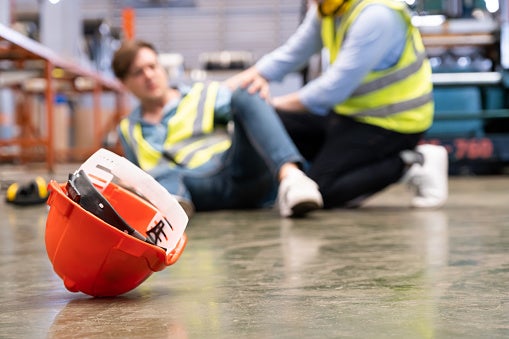-
What to Do After a Slip & Fall Accident
So, you’ve been injured from falling or some dangerous area or condition. What are the first things you should do?
The steps to take depend on where you fell. Two common locations of a slip and fall are either at a private establishment (restaurant, shopping center, business, etc.) or a public area (sidewalk, street, parks, playgrounds, public beach, etc.) The steps differ depending on the location, as outlined below:

Immediate Actions to Take
PRIVATE ESTABLISHMENT (Ex: Restaurants, shopping centers, private businesses):
What do I do at the Incident Scene?
- Call 9-1-1. It is critical to call the police immediately as they will document and report how the incident happened, whether anyone sustained injuries, and obtain witness information that will be critical to your case in the future.
- Contact the Manager. It is critical to inform the establishment of the incident and your potential injuries. Locate an employee or manager at the incident scene to inform them of what happened.
-
- Ask for an Incident Report. Asking for an incident report will allow your attorney to have a clear understanding of liability and show that an accident did occur in that establishment. Once the incident report is filled out ask for it to be signed by the manager on duty and ask that they provide YOU a copy of the incident report at the accident scene. The establishment will likely not give you a copy of the incident report if you do not obtain it on the day of the incident.
-
- Photograph the Evidence. Take photographs of the accident scene, the position where you fell, and any posted signs (if any), such as “Wet Floor” or “Step Down” etc.
-
- Surveillance Cameras: There’s a possibility that there was a camera that captured the incident. Be sure to take a photograph of the camera and it’s positioning so that your attorney can request the footage later.
-
- Establishment Information. Be sure to take photographs of the establishment’s license to operate, insurance information, and the manager’s name, number, and possibly employee ID.
- Say YES to the Ambulance. If you are in ANY pain or discomfort after the incident and the paramedics or police officer asks you whether you want to be taken to the hospital by ambulance, say YES. If you deny an ambulance and later learn that you sustained injuries, the defendant can later use your denial against you.
PUBLIC AREA (Ex: sidewalk, public park, public beach, playground, etc.)
What do I do at the Incident Scene?
- Call 9-1-1. It is critical to call the police immediately as they will document and report how the incident happened, whether anyone sustained injuries, and obtain any witness information that will be critical to your case in the future.
- Photograph the Evidence. Take photographs of the accident scene, the position where you fell, any posted signs or marking (if any), such as colored markings on the sidewalk or any other posted warnings that relate in any way to the area or condition that caused your injury.
-
- Surveillance Cameras: There’s a possibility that there was a camera that captured the incident. Be sure to take a photograph of the camera and its positioning so that your attorney can request the footage later.
-
- Say YES to the Ambulance. If you are in ANY pain or discomfort after the incident and the paramedics or police officer asks you whether you want to be taken to the hospital by ambulance, say YES. If you deny an ambulance and later learn that you sustained injuries, the defendant can later use your denial against you.
MEDICAL TREATMENT
- Day of Accident: If you’re not taken by ambulance, visit the ER or Urgent Care immediately to be assessed for any possible injuries.
-
- Be descriptive with the doctor. All details help your case. It’s better to be overly thorough than to leave out critical information that could assist the doctor.
- When speaking of a doctor about the accident, describe how the incident occurred, how your body moved when you slipped, jolted, or fell, and include in your description what parts immediately hurt and what parts are sore, etc.
- It is a good idea to call your primary care doctor while waiting to be seen at the ER. Your primary care doctor likely will not be able to see you for a couple days, maybe weeks after the accident. So, it is critical to call them ASAP to get a visit date scheduled.
-
- Additional Medical Visits: If you have not already, call your primary care doctor to schedule an appointment. ER and Urgent care facilities will likely not provide ongoing treatment, only emergency treatment. Accordingly, you will need to see your primary care doctor for additional, follow-up care.
-
- No Primary Care Doctor or Health Insurance? Contact our office at (951) 688-7000 as our attorneys can refer you to a medical professional.
-
COMMUNICATIONS AFTER THE INCIDENT
If ANYONE from either the private establishment or public official (such as a representative from the city) calls you, do not speak to them. Tell them that if they have any questions, they can speak to your attorney.
OTHER EVIDENCE
- Ongoing Evidence: Due to the accident, you may have cuts, bruises, and other marks on your body that will hopefully go away in the future. It is important to take photos of these visible injuries before they go away. The insurance company may deny that you suffered visible injuries unless you capture the evidence.
- If someone witnessed the incident, ask them for their name and number. Even if this incident occurred inside a private establishment or public area, ask for the witness’s name and number. This way your attorney can use them as a possible witness in the future to add more credibility to your claims.
- Diary Log: Be sure to keep a diary of any abnormal symptoms you experience. For example, nausea, vomiting, and sensitivity to light can be signs of a concussion or brain injury. It is important that you note any abnormal feelings you experience so that you can communicate each symptom to your doctor.
-
- Example Log: “On July 1st, 2024, I saw my chiropractor and advised them that I have been experiencing a numbness and tingling sensation in my right arm.”
- Other Log Info: This log is also not limited to medical visits. It could also be day-to-day life for example, “I was not able to ride my Harley Davidson this Sunday because of the pain in my back.”
-
- Future evidence: If at some point you visit the place where the incident occurred, and you notice that the area where you were injured has been changed or fixed, be sure to take photos so that your attorney can compare the before and after the condition of the area you fell.
Call my office if you have any questions regarding the above. The firm’s number is (951)-688-7000.
-
Determining Causation in Court
One of the primary tasks of personal injury lawyers serving the Riverside area is proving causation. This refers to whether the negligent actions taken by the defendant caused the plaintiff’s slip and fall injury. Watch this featured video to learn about two types of causation and how they might be proven in court.
“But for” causation indicates that, but for the defendant’s actions, the plaintiff would not have sustained the injury. For example, but for the defendant’s failure to clear the aisles of a store, the plaintiff would never have been in a trip and fall accident. Another type is substantial causation. This means that the injury might have occurred anyway, but the defendant’s actions substantially contributed to it. As an example, a hypothetical plaintiff with pre-existing knee pain files a personal injury lawsuit, claiming the defendant’s failure to clear the aisles of a store resulted in a fall that required knee replacement surgery. Since the plaintiff has a history of knee problems, he or she might have needed the surgery at some point anyway. However, the defendant’s actions substantially contributed to the worsening of the knee pain, which led to the surgery.
-
Who Is Liable for Climbing Wall Injuries?
Indoor rock climbing gyms are a great way to experience the thrill of the sport without worrying about falling off a cliff hundreds of feet in the air. But even indoor climbing walls present the possibility of injuries, and injured climbers might not always be the responsible party. A climbing wall injury case can be a little more complicated than the average slip and fall lawsuit . Consult a personal injury lawyer serving the Riverside area who has plenty of experience with complicated types of premises liability cases.

Assessing the Possibility of Product Liability
Injured climbers might assume that the gym is usually to blame for an accident and their subsequent injuries. But this isn’t necessarily true in all cases. Your personal injury lawyer will consider whether the climbing equipment was inherently defective in design or manufacture. If so, then the manufacturer could be held liable for the damages. For example, the manufacturer might have produced the carabiner out of a poor quality of aluminum alloy that caused it to malfunction. One possible defense to this claim is that the climber was using the equipment in a manner not intended by the manufacturer. Hypothetically, if the climber decided to light the climbing rope on fire, and the climber fell as a result, then the manufacturer would not be found liable because the rope was never supposed to be lit on fire. Additionally, the climber could be found liable for the damage to the equipment and gym.
Taking a Closer Look at Gym Waivers
One key piece of evidence in any climbing gym lawsuit is the waiver. Climbers are required to sign a waiver before they’re allowed to use the equipment, and many of them don’t read the full document. The premises liability attorney will need to carefully examine the waiver, and consider the facts of the case in light of the provisions in the document. Liability waivers are supposed to prevent climbers from suing the gym in the event of an injury. However, if the gym owner or supervisor can be proven negligent, climbers can usually file a lawsuit regardless.
Learn more about our personal injury services here or read some of our client testimonials here.
““
-
Environmental Hazards: How Victims Got Justice
If someone’s spouse dies as a result of acute toxicity from pesticides or chemicals, the surviving victim may have legal recourse. This could include a wrongful death claim that falls under the category of toxic torts. Toxic torts are claims filed by a personal injury lawyer in Riverside. They seek compensation for the victims based on the defendant’s negligence in causing the decedent to be exposed to deadly environmental hazards. A personal injury lawsuit won’t bring the decedent back, but it can allow the surviving family members to attain a sense of justice. It’s also possible to file a toxic tort in the absence of a wrongful death, as long as the injuries were directly caused by the negligent act.

Legal Concepts Regarding Toxic Torts
Like other personal injury lawsuits, a toxic tort claim is based on the legal concepts of liability and negligence. Negligence refers to any careless behavior that leads to the plaintiff’s injury or the decedent’s wrongful death. Liability means that the defendant has been found responsible. In order to win a favorable jury verdict for the plaintiff, the lawyer must prove the following:
- The defendant owed a duty to act with reasonable care toward the public or a specific person.
- The defendant’s careless behavior failed to meet this duty of reasonable care.
- The defendant’s careless behavior caused the plaintiff to suffer harm.
Hypothetically, assume that the defendant is the owner of a farm that grows peppers, and he or she uses pesticides on the fields. The plaintiff is a farmworker who was exposed to toxic levels of pesticides after being instructed to apply the chemicals. The plaintiff may sue the defendant for these injuries if the defendant failed to provide the worker with the necessary safety equipment.
Examples of Toxic Torts
Toxic torts can be based on a wide range of allegations. For instance, plaintiffs may claim that a landfill or manufacturing plant polluted their groundwater, causing cancers and birth defects. One of the most well-known toxic torts is the Love Canal case. In the mid-1900s, Hooker Chemicals & Plastics Corp. used a dump site at Love Canal, New York to bury 22,000 tons of hazardous chemicals. During the next two decades, the chemicals seeped into the pipes and into the air. More than 1,000 families had to leave their homes permanently, and more than 600 personal injury lawsuits were filed. The cases resulted in multi-million dollar settlements.
-
Understanding Comparative Negligence
Some states are comparative negligence states, and others follow contributory negligence rules. The difference between these two models will be important if you ever file a personal injury lawsuit in Riverside. Since California is a comparative negligence state, you can still recover compensation for your losses even if you were partially at fault for your slip and fall injury. Hear how this works by watching this brief video.
It uses the hypothetical example of Perry and David. Perry is walking on the street while immersed in a handheld videogame. David is listening to music while skateboarding. David crashes into Perry, and Perry sues David for his injuries. The jury determines that Perry is 40% responsible for the accident, which means David is 60% responsible. The rules of comparative negligence state that Perry’s monetary award will be reduced by 40%.
““
-
Can You Sue for Intentional Injuries?
Battery is the act of injuring someone without legal justification. If you’ve been physically attacked by someone, you can consult a personal injury lawyer in the Riverside area to determine if you have a legitimate personal injury claim. The law does allow victims to sue for intentionally inflicted injuries, but there are exceptions. Your personal injury attorney will need to review the police report and your medical records.
The professional featured in this video explains that you can legally defend yourself in a fight and retain the right to sue for damages. However, your claim isn’t likely to be successful if your actions cross the line from acting in self-defense to acting as an aggressor. Your personal injury lawyer will assess whether your use of force corresponded to the use of force by your attacker.
-
Common Questions About Dog Bite Claims
Most dogs are friendly, lovable family pets. Unfortunately, even dogs that are normally mild-mannered can inexplicably attack people. If you were bitten by someone else’s dog, you may be eligible to file an accident lawsuit in a Riverside-area court. Speak with a lawyer who handles accident cases to find out what you need to do to protect your legal rights and options.

What is strict liability?
California is a strict liability state with regard to dog bite cases. This means that defendants cannot successfully argue that they are not liable because the dog did not have a history of aggressive behavior. Defendants also cannot argue that they took all reasonable precautions to prevent injury to others. Regardless of these factors, the dog’s owner may still be held liable for the plaintiff’s losses.
Does it matter where the incident occurred?
Sometimes, yes. Dog attacks often occur in public places, such as when the owner is walking the dog. In this case, the injured party can usually file an accident lawsuit. If the dog attack occurred on private property, then your accident attorney will need to consider whether you were lawfully on that property. If so, you may have a claim.
Why does California have criminal and civil dog bite laws?
Although the strict liability statute does not require dogs to be considered vicious in order to hold owners liable, California does still have statutes that apply to dangerous and vicious dogs. In this state, a dangerous dog is one that has bitten another person in an unprovoked incident and caused an injury labeled as “non-severe.” A dangerous dog might have injured, bitten, or killed another domestic pet twice within 36 consecutive months while away from the dog’s owner’s property. Two separate acts of aggression toward humans within 36 months while away from the owner’s property also fit this category. A dog that is legally considered vicious has severely injured or killed a person, or is owned by someone with an illegal dog fighting conviction. If the owner of a dog legally considered dangerous or vicious fails to exercise reasonable care and the dog causes serious injuries or death, then the owner may be charged with a misdemeanor or felony. However, criminal charges proceed separately from civil accident lawsuits. Even if the owner is facing criminal charges, he or she may still be held liable in civil court.
-
The Signs of Elder Abuse
Elder abuse is an unspeakable tragedy, and it often goes unreported. Nearly 10% of all seniors in the U.S. become victims of elder abuse. This is a tragedy that you can help put an end to. Be alert to the signs of elder abuse , and contact the police and a personal injury lawyer in Riverside if you notice them. If you believe a senior is in imminent danger, call 911 immediately. Otherwise, a personal injury lawyer can walk you through the process of seeking legal recourse.
Types of Elderly Abuse
To learn about the types of elder abuse, watch this featured video and consult your personal injury lawyer about your own observations. Your personal injury lawyer may ask you about suspicious physical problems, such as unexplained bruises, lacerations, or broken bones. Some seniors are medically neglected. Their caregivers may fail to give them prescribed medications, neglect to take appropriate actions to prevent bedsores, and fail to call a doctor when needed.
-
O.J. Simpson: Understanding an Infamous Wrongful Death Lawsuit
In 1994, the country was horrified to learn of the violent deaths of Nicole Brown Simpson and Ron Goldman. Simpson’s ex-husband, former NFL player O.J. Simpson, was acquitted of the murders. However, a civil lawsuit was brought against him and he was found liable for wrongful death. There are significant differences between verdicts in criminal cases and the outcomes of wrongful death accident lawsuits. If you’ve lost a loved one due to someone else’s actions, you can consult an accident lawyer in Riverside to discuss how an accident lawsuit would proceed differently from a criminal case.
As you’ll learn when you watch this featured video, a verdict in a criminal trial is not binding on a civil accident lawsuit. One of O.J. Simpson’s defense lawyers points out that the burden of proof is different. In a criminal case, a defendant must be found guilty beyond a reasonable doubt. In a civil accident lawsuit, a defendant must be found liable by a preponderance of the evidence.
-
Common Injuries of Nursing Home Residents
Families often prefer to keep their aging loved ones at home, but unfortunately, this isn’t always possible. Even if your family chooses a nursing home with a solid reputation, it’s important to know that any nursing home resident can become injured due to negligence or abuse. Visit your loved one often and remain alert to the potential signs of negligence. If the resident does sustain unexplained injuries or illnesses, consult a nursing home abuse lawyer in Riverside immediately.
Medication Mistakes

Medication errors can be especially tricky to detect, since family members cannot monitor their loved ones 24/7. But if you do notice that your loved one’s medical conditions seem to be worsening, it might be a sign that the nursing home staff isn’t administering the doses as prescribed. Consider having a frank discussion with your loved one’s doctor about this possibility. A physician can let you know about the side effects or symptoms that you should watch out for. If your loved one is hospitalized with a mysterious illness, you could ask if a blood test might reveal medication levels.Dehydration
Dehydration is a major concern for responsible caretakers of elderly nursing home residents. As a person grows older, thirst recognition isn’t as strong. Plus, many medications can increase the risk of dehydration. Seniors suffering from dehydration may have dizziness, difficulty walking, confusion, low blood pressure, and a rapid heart rate. Since seniors are at a high risk of severe complications of dehydration, they should be seen at a hospital promptly if these symptoms occur. Bear in mind, however, that as a person approaches the end of life, he or she is likely to refuse food and water. Consider whether your loved one’s doctor has advised you to expect his or her impending death before jumping to conclusions about nursing home neglect.
Pressure Sores
Another common nursing home injury is pressure sores, also known as bedsores or pressure ulcers. Many nursing home residents have mobility restrictions. They need assistance at regular intervals to change their positioning and to transfer from a bed to a wheelchair. If a nursing home resident hasn’t been repositioned properly, pressure sores can quickly develop. They most commonly affect the hips, heels, back, ankles, and elbows. Pressure sores become progressively worse when not treated promptly. Eventually, the lesions can cause life-threatening infections .
RECENT POSTS
categories
- Uncategorized
- Slip & Fall
- Dog Bites
- Personal Injury
- Motorcycle Injury
- Truck Accident
- Accident Lawyer
- Car Crashes
- Infographic
- Nursing Home Abuse
- Non-Economic Damages
- Wrongful Death
- Personal Injury Lawyer
- Birth Injuries
- Taser Injuries
- Slip and Fall Attorney
- Government Liability Cases
- Settlement Offers
- Private Nuisance Lawuits
- Impacted Fracture
- Tort Law
- Burn Injury
